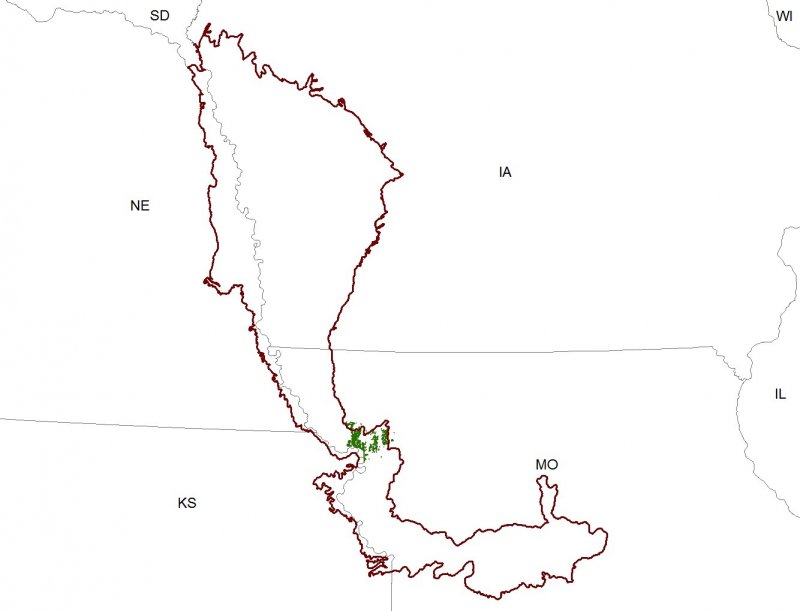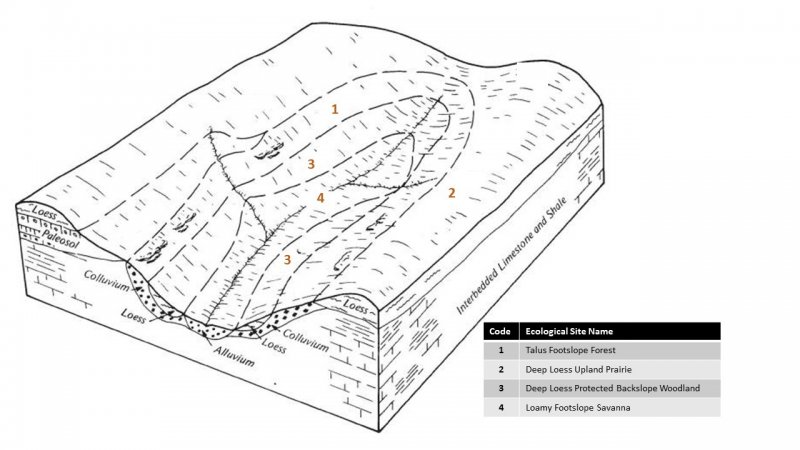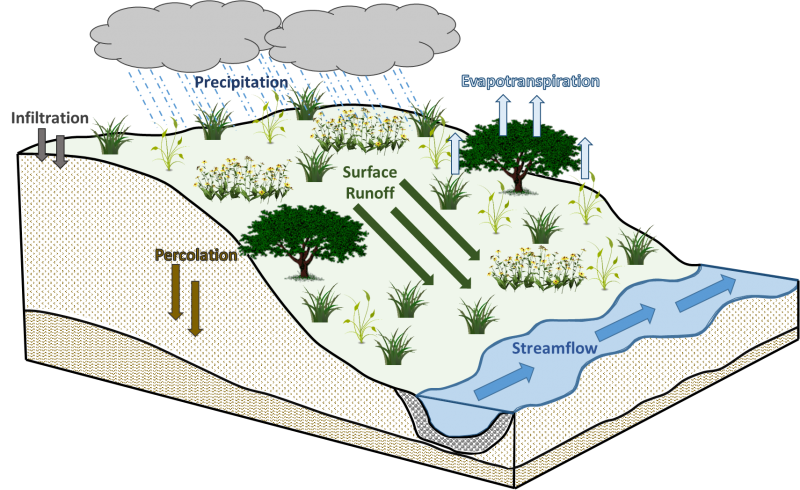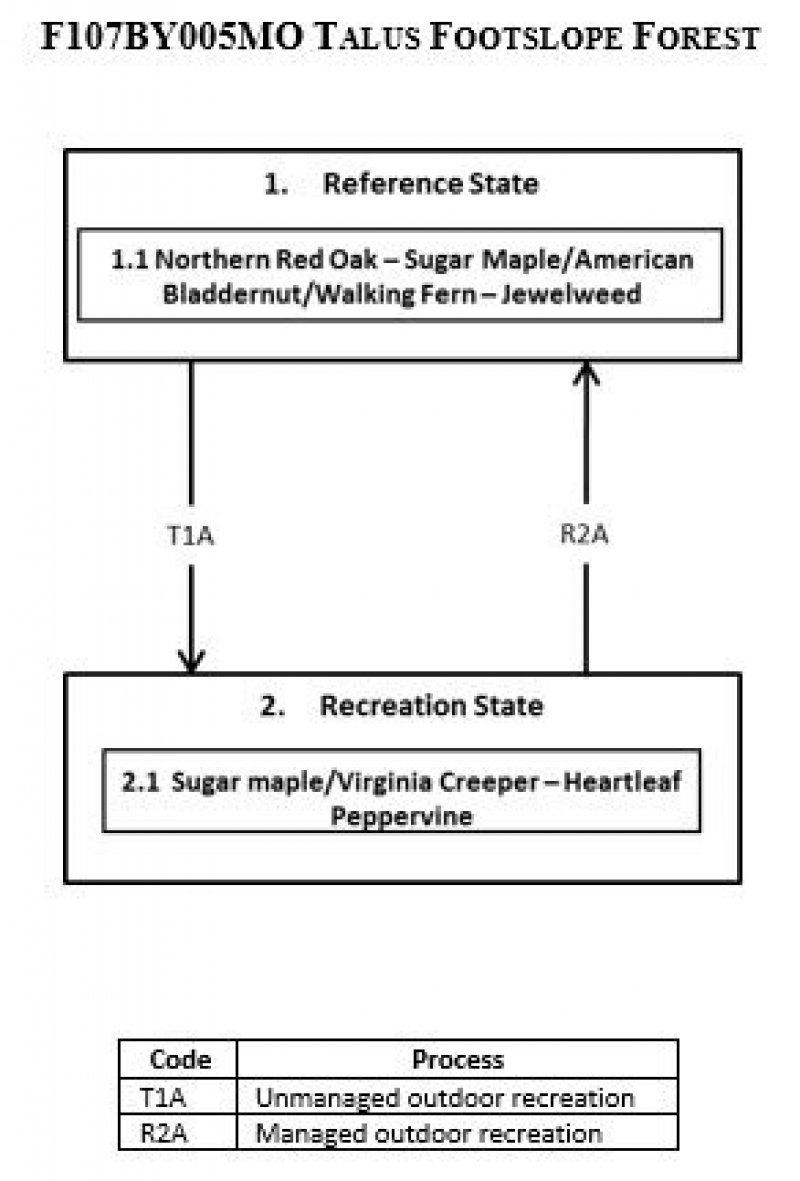
Natural Resources
Conservation Service
Ecological site F107XB005MO
Talus Footslope Forest
Last updated: 5/21/2020
Accessed: 12/21/2025
General information
Provisional. A provisional ecological site description has undergone quality control and quality assurance review. It contains a working state and transition model and enough information to identify the ecological site.
Figure 1. Mapped extent
Areas shown in blue indicate the maximum mapped extent of this ecological site. Other ecological sites likely occur within the highlighted areas. It is also possible for this ecological site to occur outside of highlighted areas if detailed soil survey has not been completed or recently updated.
MLRA notes
Major Land Resource Area (MLRA): 107X–Iowa and Missouri Deep Loess Hills
The Iowa and Missouri Deep Loess Hills (MLRA 107B) includes the Missouri Alluvial Plain, Loess Hills, Southern Iowa Drift Plain, and Central Dissected Till Plains landform regions (Prior 1991; Nigh and Schroeder 2002). It spans four states (Iowa, 53 percent; Missouri, 32 percent; Nebraska, 12 percent; and Kansas 3 percent), encompassing over 14,000 square miles (Figure 1). The elevation ranges from approximately 1,565 feet above sea level (ASL) on the highest ridges to about 600 feet ASL along the Missouri River near Glasgow in central Missouri. Local relief varies from 10 to 20 feet in the major river floodplains, to 50 to 100 feet in the dissected uplands, and loess bluffs of 200 to 300 feet along the Missouri River. Loess deposits cover most of the area, with deposits reaching a thickness of 65 to 200 feet in the Loess Hills and grading to about 20 feet in the eastern extent of the region. Pre-Illinoian till, deposited more than 500,000 years ago, lies beneath the loess and has experienced extensive erosion and dissection. Pennsylvanian and Cretaceous bedrock, comprised of shale, mudstones, and sandstones, lie beneath the glacial material (USDA-NRCS 2006).
The vegetation in the MLRA has undergone drastic changes over time. Spruce forests dominated the landscape 30,000 to 21,500 years ago. As the last glacial maximum peaked 21,500 to 16,000 years ago, they were replaced with open tundras and parklands. The end of the Pleistocene Epoch saw a warming climate that initially prompted the return of spruce forests, but as the warming continued, spruce trees were replaced by deciduous trees (Baker et al. 1990). Not until approximately 9,000 years ago did the vegetation transition to prairies as climatic conditions continued to warm and subsequently dry. Between 4,000 and 3,000 years ago, oak savannas began intermingling within the prairie landscape, while the more wooded and forested areas maintained a foothold in sheltered areas. This prairie-forest transition ecosystem formed the dominant landscapes until the arrival of European settlers (Baker et al. 1992).
Classification relationships
Major Land Resource Area (MLRA): Iowa and Missouri Deep Loess Hills (107B)
USFS Subregions: Central Dissected Till Plains Section (251C); Loess Hills (251Cb) (Cleland et al. 2007)
U.S. EPA Level IV Ecoregion: Rolling Loess Prairies (47f)
Ecological Systems (National Vegetation Classification System, Nature Serve 2015): Central Interior Calcareous Cliff and Talus (CES202.690)
Missouri Natural Heritage Program (Nelson 2010): Limestone/Dolomite Talus
Plant Associations (National Vegetation Classification System, Nature Serve 2015): Limestone – Dolomite Midwest Talus Vegetation (CEGL002308)
Ecological site concept
Talus Footslope Forests are located within the green areas on the map (Figure 1). They occur on upland footslopes on very steep slopes (14 to 50 percent) and are small in patch size (less than one acre). Soils are Mollisols that are well-drained and deep, formed from clayey-skeletal limestone colluvium with numerous coarse fragments, stones, and boulders.
The historic pre-European settlement vegetation on this site was dominated by a sparse to nearly absent canopy of trees. Northern red oak (Quercus rubra L.) and sugar maple (Acer saccharum Marshall) are characteristic species of this ecological site. The shrub layer is more developed and includes American bladdernut (Staphylea trifolia L.). Herbaceous species typical of an undisturbed plant community associated with this ecological site include northern maindenhair (Adiantum pedatum L.) and great waterleaf (Hydrophyllum appendiculatum Michx.) (Nelson 2010; Ladd and Thomas 2015). The primary disturbance factor for this site is unconsolidated material accumulation as a result of weathering, rockfall, and erosion from adjacent cliffs and steeply sloping uplands (Nelson 2010).
Associated sites
| F107XB016MO |
Loamy Floodplain Forest Silty alluvium soils on floodplains adjacent to stream channel including Blake, Danbury, Floris, Gilliam, Grable, Grable variant, Haynie, Haynie variant, Kenridge, Landes, Lossing, McPaul, Modale, Modale variant, Moniteau, Morconick, Motark, Moville, Nodaway, Omadi, Paxico, Ray, Rodney, Scroll, Ticonic, Udifluvents, Udorthents, and Waubonsie |
|---|---|
| F107XB015MO |
Sandy/Loamy Floodplain Forest Clayey alluvium soils on floodplains adjacent to stream channel including Albaton, Blencoe, Blend, Leta, Myrick, Onawa, Onawet, Owego, Parkville, Percival, and SansDessein |
| R107XB002MO |
Deep Loess Upland Prairie Loess soils on summits and shoulders including Arents, Contrary, Deroin, Higginsville, Knox, Melia, Menfro, Monona, Ponca, Sibley, Strahan, Udarents, Udorthents, and Wakenda |
| R107XB008MO |
Loamy Footslope Savanna Loess soils on footslopes including Castana, Colo, Danbury, Ely, Judson, Napier, Nodaway, Olmitz, Udarents, and Udorthents |
| F107XB004MO |
Deep Loess Protected Backslope Woodland Loess soils on backslopes including Knox, Marshall, Monona, Udarents, and Udorthents |
Table 1. Dominant plant species
| Tree |
(1) Quercus rubra |
|---|---|
| Shrub |
(1) Staphylea trifolia |
| Herbaceous |
(1) Asplenium rhizophyllum |
Click on box and path labels to scroll to the respective text.




